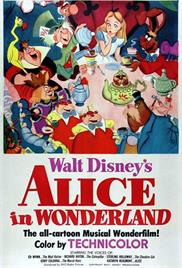Be Careful of Fake Websites. Always use HindiMovies.to domain & Join our Telegram Channel for Latest Updates.

Likes: 12
Views: 5.23K
Alice is a daydreaming young girl. She finds learning poems and listening to literature boring. She prefers stories with pictures and to live inside her imagination. One day, while enduring just such a poetry reading, she spots a large white rabbit…dressed in a jacket and carrying a large watch. He scurries off, saying he’s late, for a very important date. She follows him through the forest. He then disappears down a rabbit hole. Alice follows, leading her to all manner of discoveries, characters and adventures.
Duration: 75 min
Released: 1951
IMDb Rating: 7.4/10 (115,115 Votes)
Genre: Adventure, Animation, Family, Fantasy
Stars: Sterling Holloway, Kathryn Beaumont, Ed Wynn, Richard Haydn
Directors: Wilfred Jackson, Clyde Geronimi, Hamilton Luske
Writers: Joe Grant, Dick Huemer, Bill Peet, Joe Rinaldi, Erdman Penner, Ted Sears, Winston Hibler, Milt Banta, William Cottrell, Lewis Carroll, Dick Kelsey, Del Connell, Tom Oreb, John Walbridge
Year: 1951
Alice in Wonderland (1951): A Timeless Animated Fantasy Adventure
The 1951 classic Alice in Wonderland is a beloved animated film brought to life by Walt Disney Productions. This enchanting movie has captured the imaginations of audiences young and old for over seven decades. Based on Lewis Carroll's famous novels Alice's Adventures in Wonderland and its sequel Through the Looking-Glass, this film weaves a colorful and whimsical tapestry filled with fantasy, adventure, and memorable characters.
Plot Overview
The story follows a curious and imaginative young girl named Alice, voiced by Kathryn Beaumont, who falls down a rabbit hole and enters the magical world of Wonderland. This fantastical place is inhabited by peculiar creatures and quirky personalities whose behavior defies logic and reason. Alice encounters a host of vivid characters such as the White Rabbit, the Cheshire Cat, the Mad Hatter, the Queen of Hearts, and more.
Throughout the film, Alice navigates the strange and unpredictable landscape, embarking on a series of adventures that challenge her perception and understanding of reality. From a chaotic tea party with the Mad Hatter and March Hare to a surreal croquet game with the mercurial Queen of Hearts, Alice’s journey is both whimsical and thought-provoking. The film masterfully blends absurdity with charm, creating a dreamlike atmosphere that perfectly encapsulates the essence of Carroll's writings.
Direction and Writing
The film was directed by a team of accomplished animators and directors: Clyde Geronimi, Wilfred Jackson, and Hamilton Luske. Their vision translated the intricate and imaginative world of the novel into a vivid animated experience that remains timeless. The screenplay was crafted by a team of writers, with notable contributions from Maurice Rapf and Ralph Wright, who adapted Carroll’s story into a format tailored for the animated medium while preserving its whimsical spirit.
Main Voice Cast
Additional talented voice actors included Mel Blanc and Lucille Bliss, among others, contributing to the rich, varied personalities throughout the movie.
Music and Songs
Unlike many of Disney’s later musicals, Alice in Wonderland (1951) leans more on atmosphere and storytelling with songs interwoven carefully to enhance the narrative rather than dominate it. The songs, composed by Oliver Wallace and Sammy Fain with lyrics by Jack Lawrence and Sammy Fain, add to the magical environment of Wonderland.
These songs were performed by the talented voice actors themselves, with additional vocals by notable singers such as Marni Nixon and Thurl Ravenscroft. The musical score and tunes are memorable, contributing significantly to the film’s enduring charm.
Animation and Artistic Style
The animation style of Alice in Wonderland (1951) is representative of Hollywood’s Golden Age of animation, featuring lush backgrounds, fluid character movements, and vibrant colors that bring Wonderland to life. The creative team used innovative techniques at the time to translate the surreal and nonsensical elements of the source material into a visual feast that still delights viewers today.
Cultural Impact and Legacy
Alice in Wonderland has become a landmark in animated cinema. Its imaginative storytelling, unique characters, and artistic excellence have influenced countless adaptations and reinterpretations over the years. The film’s approach to bringing such an abstract narrative to the screen is noteworthy and demonstrates the timeless appeal of Lewis Carroll’s work.
Whether experienced as a child mesmerized by its fantasy or an adult appreciating its creativity and whimsy, this Disney classic remains a vital part of cinematic history. It continues to inspire audiences with its message about curiosity, imagination, and the joy of exploring the unknown.
Conclusion
Disney’s Alice in Wonderland (1951) elegantly captures the enchanting yet puzzling essence of Wonderland with a combination of charming voice performances, captivating animation, and memorable songs. Directed by Clyde Geronimi, Wilfred Jackson, and Hamilton Luske, and featuring memorable voices from Kathryn Beaumont, Ed Wynn, Sterling Holloway, and many others, the film transports viewers to a fantastical realm where logic turns topsy-turvy. A triumph of storytelling and animation, it remains a cherished classic that invites audiences to ponder the boundaries between reality and imagination.